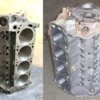Steve, no such thing as an ignorant question! The only bad question is the one that goes unasked!
The whole "small block" concept is kind of muddled when you are talking about Ford engines. Its best to think of Fords as engine "series", and in this case I'm going to focus on 2 engine series, the Windsor engines and the 335 series engines.
In the minds of most people there are 3 Ford small block push rod V8s: the little 260 / 289 / 302 / 5.0 with an 8.2" block deck height; the 351C with a 9.2" block deck height; and the 351W with a 9.5" block deck height. The 302 & 351W were both cast in Windsor Canada. I think these engines are small blocks in the minds of most people because they compete in the same displacement class as the small block Chevy.
All 3 of these V8 motors share the same bore spacing, motor mount and bell housing bolt patterns, and interchange in many instances fairly easily. Cleveland heads will bolt onto a 302W or 351W block with a simple coolant passage modification, and a new set of pistons (valve reliefs are different). I'm over simplifying that a bit, of course. Not much else interchanges between the Cleveland and the 2 Windsor motors.
The dimensions of the 351C block are very nearly identical to the small block Chevy, while the 351C cylinder head has several similarities to the big block chevy's head. The 302 & 351W cylinder heads are almost carbon copies of the small block chevy cylinder heads, except for the spacing of the ports.
There is one other motor I must include in this discussion, the 351M / 400. Gary (comp2) is building a stroker for his Pantera based on this block. It has a foot in two Ford engine camps, but Ford considers the 351C / 351M / 400 as the same series of motors, they are referred to as 335 series. So from that perspective, the 351M / 400 is also a "small block". The 351M / 400 shares the same bore spacing as the previously mentioned small block Fords, the same cooling system as the Cleveland, it uses Cleveland cylinder heads, Cleveland camshaft, Cleveland oil pump & pan, Cleveland timing cover, and a Cleveland distributor. The main bearing journals are the same size as the 351W. BUT, the motor mount bolt pattern and bell housing bolt pattern are the same as the 385 series Ford big block (429 / 460). There is one exception to this, in 1973 Ford produced a batch of 400 motors with the small block bell housing bolt pattern, folks refer to this unique block as the fmx block because it was cast to allow it to use the fmx automatic transmission with a small block bellhousing, the block's casting number was D3AE-B.
The 351M / 400 has a 10.3" high block deck height (1.1" higher than the Cleveland). This is the same height as the 385 series big block, and about 1/8" higher than Fords other big block, the FE series (390, 427, 428).
You've noticed there are 3 Fords with the same diplacement, the 351C, the 351M and the 351W. The C stands for Cleveland Ohio, and the W for Windsor, Ontario, Canada. These are the cities where the respective engine plants are located.
The M engine was cast in the Michigan Casting Center. Some say the M stands for Midland. There is a city in Michigan called Midland, but I do not know if that's where the Michigan casting center is located. The M designates one or the other.
OK, its all clear now, right? LOL

Your friend on the PIBB, George



